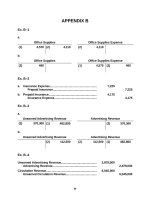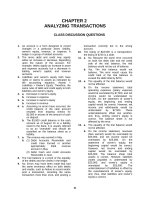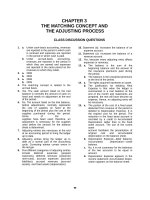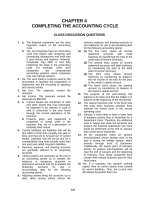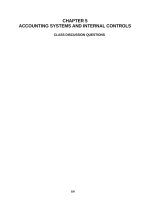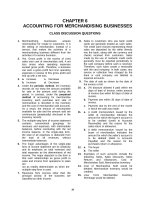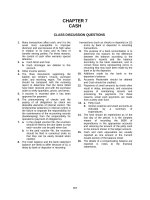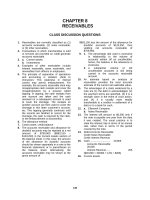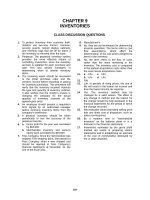Solution manual accounting 21e by warreni ch 18
Bạn đang xem bản rút gọn của tài liệu. Xem và tải ngay bản đầy đủ của tài liệu tại đây (184.8 KB, 39 trang )
CHAPTER 18
INTRODUCTION TO MANAGERIAL ACCOUNTING
AND JOB ORDER COST SYSTEMS
CLASS DISCUSSION QUESTIONS
1. Managerial accounting and financial
accounting are different in several ways.
Managerial accounting is concerned with
the information needs of internal decision
makers, rather than external decision
makers. As such, managerial accounting is
not subject to a defined set of reporting
rules. Management accountants have
reasonable latitude in providing information
that is useful to managers. Managerial
accounting has very few set rules to govern
how it is done. The idea of different costs
for different needs suggests that there isn’t
just one way to view business events. Like
financial
accounting,
managerial
accounting reports can be prepared
periodically.
In
addition,
managerial
accounting reports can also be prepared at
any time to support a decision. Like
financial
accounting,
managerial
accounting reports provide information
about the business as a whole. Also,
managerial accounting reports provide
information about any level of the
organization as required by management.
2. a. A line department is directly involved in
the basic objectives of the organization,
while a staff department provides
service, assistance, or advice to line
departments or other staff departments.
b. (1) Sales Department
(2) Personnel Department
3. a. The role of the controller is to provide
financial and accounting advice and
assistance to management.
b. The controller has a staff responsibility.
4. Memory chips would be considered a direct
materials cost for a desktop computer.
5. Product cost information is used by
managers to (1) establish product prices,
(2) control operations, and (3) develop
financial statements.
6. a. Job order cost system and process cost
system.
7.
8.
9.
10.
11.
1
b. The job order cost system provides a
separate record of each quantity of
product that passes through the factory.
c. Process cost systems accumulate costs
for each department or process within a
factory.
Job order costing is used by firms that sell
custom goods and services to customers.
The job order system is frequently
associated with firms that will produce a
product or service specifically to a
customer order.
No. A job order cost system is not
appropriate because workers could not
physically
differentiate
between
the
products being worked on in different
orders.
Materials should not be issued by the
storekeeper without a properly authorized
materials requisition. Both the storekeeper
and the recipient of the materials should
initial the materials requisition when the
materials are issued to indicate release of
the proper amount of materials from the
storeroom.
a. The clock card is a means of recording
the hours spent by employees in the
factory. The time ticket is a means of
recording the time the employee
spends on a specific job or, in cases of
indirect labor (factory overhead), the
department in which the time was
spent.
b. The total time reported on an employee’s
time tickets for a payroll period is
compared with the time reported on the
employee’s clock cards as an internal
check on the accuracy of payroll
disbursements.
The sources of the debits to Work in
Process are:
a. Summary of the materials requisitions
for direct materials.
b. Summary of the time tickets for direct
labor.
c. Data obtained when applying the
predetermined factory overhead rate for
factory overhead.
2
12.
The use of a predetermined factory
overhead rate in job order cost accounting
assists management in pricing jobs. By
estimating the cost of direct materials and
direct labor based on past experience and
by applying the factory overhead rate, the
cost of a job can be estimated. The
predetermined rate also permits the
determination of the cost of a job shortly
after it is finished, which enables
management to adjust future pricing
policies to achieve the best combination of
revenue and expense.
13. a. The predetermined factory overhead
rate is determined by dividing the budgeted factory overhead for the forthcoming year by an estimated activity
base, one that will equitably apply the
factory overhead costs to the goods
manufactured.
b. Direct labor cost, direct labor hours,
and machine hours.
14. a. (1) If the amount of factory overhead
applied is greater than the actual
factory overhead, factory overhead
is overapplied.
(2) If the amount of actual factory
overhead is greater than the
amount applied, factory overhead
is underapplied.
b. Underapplied
c. Deferred credit
15. The simplest satisfactory procedure for
disposing of a relatively minor balance in
the factory overhead account is to transfer
it to Cost of Goods Sold.
16. Product costs are composed of three
elements of manufacturing costs: direct
materials cost, direct labor cost, and factory
overhead cost. These costs are treated as
assets until the product is sold. Product
costs are sometimes referred to as
inventoriable costs. Period costs are costs
that are used in generating revenue during
the current period. They are recognized as
expenses on the current period’s income
statement.
17. Job cost information can be used to identify
trends in unit costs over time for like
products. Comparative job cost sheets for
like products can be used to investigate
possible reasons for cost changes. This
information can help managers identify
changes
in
efficiency,
methods,
procedures, and prices used in the
manufacturing process.
18. Job order cost accumulation would be most
appropriate for professional service firms
that provide extended, project-type services
for
clients.
Examples
would
be
architectural, consulting, advertising, or
legal services. Job cost sheets would
accumulate all direct costs of servicing the
client. Such costs would include labor,
materials,
travel,
and
subcontracted
services. In addition, overhead would be
applied using a predetermined overhead
rate. The costs accumulated by the job cost
sheet would be treated as work in process
(a current asset) until the service is
completed. Once completed, the cost
would be transferred to the cost of services
on the income statement.
3
EXERCISES
Ex. 18–1
a.
b.
c.
d.
factory overhead
factory overhead
direct labor
direct materials
e.
f.
g.
h.
direct labor
direct materials
factory overhead
factory overhead
f.
g.
h.
i.
j.
direct materials
direct labor
direct materials
factory overhead
factory overhead
i.
j.
k.
l.
m.
n.
o.
p.
Product
Product
Product
Period
Period
Period
Product
Product
e.
f.
g.
h.
period
work in process inventory
direct materials
plant depreciation
Ex. 18–2
a.
b.
c.
d.
e.
factory overhead
direct labor
factory overhead
direct materials
factory overhead
Ex. 18–3
a, c, g, i, j
Ex. 18–4
a.
b.
c.
d.
e.
f.
g.
h.
Period
Product
Product
Period
Period
Period
Product
Product
Ex. 18–5
a.
b.
c.
d.
product
conversion
increases
costs
4
Ex. 18–6
a.
b.
c.
d.
e.
Materials requisitioned for use (both direct and indirect).
Factory labor used (both direct and indirect).
Application of factory overhead costs to jobs.
Jobs completed.
Cost of goods sold.
Ex. 18–7
a.
Cost of goods sold:
Sales...................................................................................
Less gross profit...............................................................
Cost of goods sold............................................................
b.
Direct materials cost:
Materials purchased..........................................................
Less: Indirect materials....................................................
Materials inventory..................................................
Direct materials cost.........................................................
c.
Direct labor cost:
Total manufacturing costs for the period........................
Less: Direct materials cost...............................................
Factory overhead....................................................
Direct labor cost................................................................
*$65,000 + $27,000 + $13,500
5
$ 850,000
235,000
$ 615,000
$ 305,000
$ 27,000
20,000
47,000
$ 258,000
$ 640,000
$ 258,000
105,500*
363,500
$ 276,500
Ex. 18–8
a.
RECEIVED
Receiving
Report
Number Quantity
23
29
190
140
ISSUED
Unit
Price
Materials
Requisition
Number Quantity
BALANCE
Amount
$20.00
104
250
117
160
$4,760*
Date
Quantity
May 1
May 3
120
120
190
60
60
140
40
May 5
May 19
22.00
3,400**
May 25
*May 5 issuance
120 at $18.00
130 at $20.00
$2,160
2,600
$4,760
**May 25 issuance
60 at $20.00
100 at $22.00
$1,200
2,200
$3,400
Amount
b. Ending wire cable balance:
40 at $22.00...............................................................
$880
c.
8,160
Work in Process ($4,760 + $3,400)................................
Materials....................................................................
Unit
Price
$2,160 $18.00
2,160
18.00
3,800
20.00
1,200
20.00
1,200
20.00
3,080
22.00
880
22.00
8,160
d. Comparing quantities on hand as reported in the materials ledger with predetermined order points enables management to order materials before a lack
of materials causes idle time. Also, the subsidiary ledger can include columns
for recording quantities ordered, so that management can have easy access
to information about materials on order.
Ex. 18–9
Work in Process...................................................................
Factory Overhead.................................................................
Materials........................................................................
6
64,950
250
65,200
Ex. 18–10
a.
Materials.........................................................................
Accounts Payable.....................................................
1,632,200
b. Work in Process.............................................................
Factory Overhead..........................................................
Materials....................................................................
1,617,600
13,500
1,632,200
1,631,100
c.
Fabric
Balance, June 1.......................... $ 32,400
June purchases.......................... 547,300
Less: June requisitions............. 539,700
Balance, June 30........................ $ 40,000
Polyester
Filling
Lumber
Glue
$ 7,300
103,600
86,700
$ 24,200
$106,900
968,100
991,200
$ 83,800
$ 1,500
13,200
13,500
$ 1,200
Ex. 18–11
Work in Process...................................................................
Factory Overhead.................................................................
Wages Payable.............................................................
14,170
12,600
26,770
Ex. 18–12
a.
Work in Process.............................................................
Factory Overhead..........................................................
Wages Payable.........................................................
1,327.80
118.20
1,446.00
Supporting Calculations:
Harvey Daniels
Cedrick Price
Dan Zhu
Hourly
Rate
Labor Costs (Hourly rate × Hours)
Direct
Labor
(sum of
Indirect
Job 111 Job 112 Job 113 job costs)
Labor
$11.50
13.25
11.40
$207.00
79.50
102.60
$172.50
92.75
148.20
$ 23.00
331.25
171.00
$ 402.50
503.50
421.80
$1,327.80
$ 57.50
26.50
34.20
$118.20
b. The direct labor costs in the completed jobs would become part of finished
goods inventory. The direct labor costs in Job 113 would remain part of work
in process inventory.
7
Ex. 18–13
a.
Work in Process.............................................................
Factory Overhead..........................................................
Wages Payable.........................................................
3,836
845
b. Work in Process.............................................................
Factory Overhead.....................................................
4,932
4,681
4,932
$3,836 ÷ $14 per hour = 274 hours
274 hours × $18 per hour = $4,932
Ex. 18–14
a.
Factory 1: $19.00 per machine hour ($237,500 ÷ 12,500 machine hours)
b. Factory 2: $12.50 per direct labor hour ($112,500 ÷ 9,000 direct labor hours)
c.
Factory 1:
Work in Process.......................................................
Factory Overhead................................................
($19.00 × 1,035)
Factory 2:
Work in Process.......................................................
Factory Overhead................................................
($12.50 × 770)
19,665
19,665
9,625
9,625
d. Factory 1—$435 debit (underapplied) ($20,100 – $19,665)
Factory 2—$175 credit (overapplied) ($9,450 – $9,625)
Ex. 18–15
The estimated shop overhead is determined as follows:
Shop and repair equipment depreciation..........................................
Shop supervisor salaries....................................................................
Shop property tax...............................................................................
Shop supplies.....................................................................................
Total shop overhead......................................................................
$ 16,900
95,200
19,200
12,200
$ 143,500
The auto parts and shop labor are direct to the jobs and are not included in the
shop overhead rate. The advertising and administrative expenses are selling and
administrative expenses that are not included in the shop overhead but are
treated as period expenses.
8
Ex. 18–15
Concluded
The estimated activity base is determined by dividing the shop direct labor cost
by the direct labor rate, as follows:
$490,000
= 35,000 hours
$14 per hour
The predetermined shop overhead rate is:
$143,500
= $4.10 per direct labor hour
35,000
Ex. 18–16
a.
Estimated annual operating room overhead: $399,000
Estimated operating room activity base, number of operating room hours:
Hours per day......................................................
Days per week.....................................................
Weeks per year (net of maintenance weeks).....
Estimated annual operating room hours...........
7
× 6
× 50
2,100
Predetermined surgical overhead rate:
$399,000
= $190 per hour
2,100 hours
b. LeVar Wilson’s procedure:
Number of surgical room hours.........................
Predetermined surgical room overhead rate.....
Procedure overhead...........................................
c.
2.5
× $190
$ 475
Actual hours used in January.......................................
Predetermined surgical room overhead rate...............
Surgical room overhead applied, January...................
Actual surgical room overhead incurred, January......
Overapplied surgical room overhead (credit bal.).......
9
170
× $190
$ 32,300
31,800
$
500
Ex. 18–17
a.
Finished Goods.............................................................
Work in Process.......................................................
b. Cost of unfinished jobs at March 31:
Balance in Work in Process at March 1...................
Add: Direct materials..............................................
Direct labor.....................................................
Factory overhead...........................................
Less: Jobs finished during March..........................
Balance in Work in Process at March 31.................
248,200
248,200
$ 15,700
84,700
63,200
92,100
$255,700
248,200
$ 7,500
Ex. 18–18
a.
Work in Process.............................................................
Factory Overhead..........................................................
Materials....................................................................
18,900
620
b. Work in Process.............................................................
Factory Overhead..........................................................
Wages Payable.........................................................
4,130
6,740
c.
7,434
Work in Process.............................................................
Factory Overhead.....................................................
19,520
10,870
7,434
Predetermined overhead rate: $2,520 ÷ $1,400 = 180% or
$1,080 ÷ $600 = 180%
Direct labor cost × Predetermined factory overhead rate:
$4,130 × 180% = $7,434
d. Finished Goods.............................................................
Work in Process.......................................................
* $10,220 + $4,880
10
15,100*
15,100
Ex. 18–19
a.
MERCURY SHOE COMPANY
Income Statement
For the Month Ended May 31, 2006
Revenues...........................................................................
Cost of goods sold............................................................
Gross profit........................................................................
Selling expenses...............................................................
Administrative expenses...................................................
Income from operations....................................................
b.
$ 510,000
300,100
$ 209,900
$116,000
48,400
164,400
$ 45,500
Materials inventory:
Purchased materials...............................................
Less: Materials used in production.......................
Materials inventory, May 31....................................
$ 155,300
145,800
$ 9,500
Work in process inventory:
Materials used in production.................................
Direct labor..............................................................
Factory overhead (75% × $94,500).........................
Additions to work in process.................................
Less: Transferred to finished goods.....................
Work in process inventory, May 31........................
$ 145,800
94,500
70,875
$ 311,175
304,300
$ 6,875
Finished goods inventory:
Transferred to finished goods.............................................
Less: Cost of goods sold....................................................
Finished goods inventory, May 31......................................
11
$ 304,300
300,100
$ 4,200
Ex. 18–20
a.
Date
Jan. 1
Jan. 29
Feb. 15
Mar. 10
Mar. 31
May 10
June 20
Aug. 2
Sept. 20
Nov. 1
Dec. 3
Job No.
Quantity
Product
Amount
Unit
Cost
1
26
43
64
75
91
104
112
114
126
133
400
1,200
600
450
900
1,000
400
1,500
400
600
850
XXY
AAB
AAB
XXY
MM
MM
XXY
MM
AAB
XXY
MM
$ 7,600
18,000
9,600
7,650
7,200
12,000
4,800
24,000
6,000
6,000
17,850
$19
15
16
17
8
12
12
16
15
10
21
Unit Cost
MM Units Costs
$25
$20
$15
$10
$5
$0
75
91
112
Job Number
12
133
Ex. 18–20
Concluded
Unit Cost
AAB Unit Costs
$20
$15
$10
$5
$0
26
43
114
Job Number
Unit Cost
XXY Unit Costs
$20
$15
$10
$5
$0
1
64
104
126
Job Number
As can be seen, the unit costs behave differently for each product. MM has
increasing unit costs during the year, AAB is steady, and XXY has decreasing
unit costs during the year.
b. Management should want to determine why MM costs are increasing and why
XXY costs are decreasing. This information can be determined from the job
cost sheets for each job. By comparing the cost sheets from job to job (for a
particular product), management can isolate the cause of the cost changes.
The cost sheets will show how materials, labor, and overhead are consumed
across the production process for each job. This information can isolate the
problem or opportunity areas.
13
Ex. 18–21
a.
The first item to note is that the cost did not go up due to any increases in the
cost of labor or materials. Rather, the cost of the plaques increased because
Job 275 used more labor and materials per unit than did Job 223. Specifically,
Job 223 required exactly the same number of backboards and brass plates as
the number of actual plaques shipped. However, Job 275 required ten more
backboards and brass plates (60 vs. 50) than the number actually shipped. In
addition, the labor hours for Job 223 were as follows:
Engraving: (42 units × 10 min. per unit) / 60 min. = 7 hours
Assembly: (42 units × 5 min. per unit) / 60 min. = 3.5 hours
These are the labor hours to be expected for 42 plaques. However, the labor
hours for Job 275 were:
Engraving: (60 units × 10 min. per unit) / 60 min. = 10 hours
Assembly: (60 units × 5 min. per unit) / 60 min. = 5 hours
Job 275’s 15 labor hours is 2.5 hours more than should have been expected
for a job of 50 plaques [(50 × 15 min.)/ 60 min. = 12.5 hrs.]. As a result, the
additional hours of labor costs, applied factory overhead, and direct material
costs cause the unit cost of Job 275 to increase.
b. Apparently, the engraving and assembly work is becoming sloppy. Job 275
required 60 engraved brass plates in order to get 50 with acceptable quality. It
is likely that the engraver is not being careful in correctly spelling the names.
The names should be supplied to the engraver using large typewritten fonts
so that it is easy to read the names. The engraver should be instructed to be
careful in engraving the names. The assembly operation also needs some
improvement. It took 60 assembly operations to properly assemble 50
plaques. It may be that the plates are assembled off-register (crooked) to the
backboard. This could be improved by using a fixture to properly align the
plate to the backboard. Alternatively, it’s possible mis-engraved plaques were
assembled to backboards and needed to be disassembled, re-engraved, and
reassembled to new backboards.
14
Ex. 18–22
a.
Mar.
7
11
22
25
30
31
31
31
31
31
Work in Process (420 hrs. × $150)...............
Salaries Payable......................................
63,000
Work in Process...........................................
Cash.........................................................
24,000
Work in Process (250 hrs. × $200)...............
Salaries Payable......................................
50,000
Work in Process...........................................
Consultant Fees Payable........................
45,000
Work in Process (670 × $50)........................
Office Overhead......................................
33,500
Office Overhead............................................
Cash.........................................................
28,000
Office Overhead............................................
Supplies...................................................
4,000
Salaries Payable...........................................
Cash.........................................................
63,000
Accounts Receivable...................................
Fees Earned.............................................
250,000
Cost of Services...........................................
Work in Process......................................
215,500
63,000
24,000
50,000
45,000
33,500
28,000
4,000
63,000
250,000
215,500*
*$63,000 + $24,000 + $50,000 + $45,000 + $33,500
b.
Office overhead incurred ($28,000 + $4,000)............
Office overhead applied.............................................
Overapplied overhead................................................
$ 32,000
33,500
$ (1,500)
c.
Fees earned.................................................................
Cost of services..........................................................
Gross profit.................................................................
$250,000
214,000*
$ 36,000
*$215,500 – $1,500. Assumes the over- or underapplied office overhead is
closed to cost of services annually.
Note to Instructors: The consultant fees and travel costs can be directly
assigned to the case and thus are not treated as office overhead. Costs such
as secretarial and administrative salaries and supplies would be part of office
overhead incurred.
15
Ex. 18–23
a.
Work in Process..................................................
Salaries Payable.............................................
230,000
b. Work in Process..................................................
Accounts Payable..........................................
510,000
c.
Work in Process (30% × $510,000).....................
Agency Overhead..........................................
153,000
d. Cost of Services..................................................
Work in Process.............................................
721,000
230,000
510,000
153,000
721,000
Cost of completed jobs, $721,000:
June 1 balance...............................................
June costs:
Direct labor...............................................
Media.........................................................
Overhead...................................................
Total costs......................................................
16
Fizz4U Bev.
$105,000
First
Security
$175,000
36,000
160,000
48,000
$349,000
15,000
140,000
42,000
$372,000
PROBLEMS
Prob. 18–1A
Cost
a.
b.
c.
d.
e.
f.
g.
h.
i.
j.
k.
l.
m.
n.
o.
p.
q.
r.
s.
t.
u.
v.
w.
x.
y.
z.
Product Costs
Period Costs
Direct Materials Direct Labor Factory Overhead Selling Administrative
Cost
Cost
Cost
Expense
Expense
X
X
X
X
X
X
X
X
X
X
X
X
X
X
X
X
X
X
X
X
X
X
X
X
X
X
17
Prob. 18–2A
a.
Materials.........................................................................
Accounts Payable.....................................................
635,500
b. Work in Process.............................................................
Factory Overhead..........................................................
Materials....................................................................
561,000
36,200
c.
Work in Process.............................................................
Factory Overhead..........................................................
Wages Payable.........................................................
370,600
97,500
d. Factory Overhead..........................................................
Selling Expenses...........................................................
Administrative Expenses..............................................
Accounts Payable.....................................................
361,100
245,000
164,500
e.
635,500
597,200
468,100
770,600
Factory Overhead..........................................................
Selling Expenses...........................................................
Administrative Expenses..............................................
Prepaid Expenses.....................................................
21,000
14,200
8,600
Factory Overhead..........................................................
Depreciation Expense—Office Equipment...................
Depreciation Expense—Warehouse Equipment..........
Accumulated Depreciation—Fixed Assets.............
36,000
21,500
9,700
g. Work in Process.............................................................
Factory Overhead.....................................................
540,500
h. Finished Goods.............................................................
Work in Process.......................................................
1,436,200
i.
1,445,500
f.
Cost of Goods Sold.......................................................
Finished Goods........................................................
18
43,800
67,200
540,500
1,436,200
1,445,500
Prob. 18–3A
1.
a. Materials....................................................................
Accounts Payable...............................................
8,100
b. Work in Process.......................................................
Factory Overhead.....................................................
Materials..............................................................
Wages Payable....................................................
12,910
1,250
c. Factory Overhead.....................................................
Accounts Payable...............................................
380
d. Factory Overhead.....................................................
Accumulated Depreciation—Machinery
and Equipment....................................................
400
e. Work in Process.......................................................
Factory Overhead (67 hours × $30)....................
2,010
f. Finished Goods........................................................
Work in Process..................................................
8,290
8,100
7,320
6,840
380
400
2,010
8,290
Computation of cost of jobs finished:
Job
No. 101
No. 102
No. 103
No. 105
Total
Direct
Materials
$ 850
1,230
630
1,250
Direct
Labor
$ 680
1,050
420
1,100
Factory
Overhead
$210
285
180
405
Total
$1,740
2,565
1,230
2,755
$8,290
g. Accounts Receivable...............................................
Sales....................................................................
11,300
Cost of Goods Sold..................................................
Finished Goods...................................................
5,535
Computation of cost of jobs sold:
Job
No. 101...........................................
No. 102...........................................
No. 103...........................................
Total...............................................
19
$1,740
2,565
1,230
$5,535
11,300
5,535
Prob. 18–3A
Continued
2.
Work in Process
(b)
(e)
6,630
3.
12,910
2,010
(f)
Finished Goods
(f)
8,290
8,290
(g)
5,535
2,755
14,920
Schedule of unfinished jobs:
Job
No. 104.................................
No. 106.................................
Balance of Work in
Process, April 30.............
Direct
Materials
Direct
Labor
$2,140
930
$1,820
810
Factory
Overhead
$630
300
Total
$4,590
2,040
$6,630
4. Schedule of completed jobs:
Job
Finished Goods, April 30
(Job 105)..........................
Direct
Materials
Direct
Labor
$1,250
$1,100
20
Factory
Overhead
$405
Total
$2,755
Prob. 18–3A
Concluded
This solution is applicable only if the P.A.S.S. Software that accompanies the text
is used.
PROFESSIONAL PRINTING COMPANY
Trial Balance
April 30, 2006
Account
Number
120
130
140
150
171
210
220
410
510
610
Account Title
Debit
Accounts Receivable......................................
Finished Goods...............................................
Work in Process..............................................
Materials..........................................................
Accum. Depr.—Mach. & Equipment...............
Accounts Payable...........................................
Wages Payable................................................
Sales................................................................
Cost of Goods Sold........................................
Factory Overhead............................................
11,300
2,755
6,630
780
Totals...............................................................
27,020
21
Credit
400
8,480
6,840
11,300
5,535
20
27,020
Prob. 18–4A
1. and 2.
JOB ORDER COST SHEET
Customer
Address
Item
Danzel Bishop
1900 Peachtree
Atlanta
Reupholster couch and chair
Date June 10, 2006
Date wanted July 16, 2006
Date completed July 11, 2006
Job. No. 00–8–38
ESTIMATE
Direct Materials
Direct Labor
Amount
9
meters at $18
Total
Summary
Amount
Amount
162.00
14 hours at $10
140.00
Direct materials
Direct labor
Factory overhead
162.00
140.00
49.00
162.00
Total
140.00
Total cost
351.00
ACTUAL
Direct Materials
Mat.
Req.
No.
U642
U651
Total
Description
4 meters
at $18
8 meters
at $18
Amount
Direct Labor
Time
Ticket
No.
72.00
1519
144.00
1520
216.00
Total
Description
8 hours
at $10
7 hours
at $10
Summary
Amount
80.00
70.00
150.00
Item
Direct materials
Direct labor
Factory overhead
Total cost
Amount
216.00
150.00
52.50
418.50
Comments:
The direct materials cost exceeded the estimate by $54 because three meters of
materials were spoiled. The direct labor cost exceeded the estimate by $10
because an additional one hour of labor was used by an inexperienced employee.
22
Prob. 18–5A
1.
Supporting calculations:
Quantity
Jan. 1
Work in
Process
Direct
Materials
No. 51 V-100
150
$ 4,000
$ 16,500
$12,500
No. 52 V-200
400
10,000
32,400
16,300
19,560
No. 53 V-500
150
8,000
5,100
6,120
No. 54 A-200
200
24,600
12,500
15,000
No. 55 V-400
160
18,800
10,600
12,720
No. 56 A-100
90
6,500
3,400
4,080
Job No.
Total
1,040
$ 14,000
$106,800
Direct
Labor
$ 60,400
Factory
Overhead
Total
Cost
Unit
Cost
$15,000 $ 48,000 $320.00
Units
Sold
Cost of
Goods
Sold
140
$ 44,800
260
50,869
0
0
52,100 $260.50
192
50,016
42,120 $263.25
148
38,961
0
0
78,260 $195.65
19,220
13,980
$ 72,480 $ 253,680
$184,646
A. $109,800. Materials applied to production in January + indirect materials.
($106,800 + $3,000)
B. $14,000. From table above and problem.
C. $106,800. From table above.
D. $60,400. From table above.
E. $72,480. $60,400 × 1.2 and from table above.
F. $220,480. ($48,000 + $78,260 + $52,100 + $42,120)
G. $184,646. From table above.
H. $13,800. Wages incurred less direct labor applied to production in January.
($74,200 – $60,400)
2. January 31 balances:
Materials
Work in Process
Finished Goods
Factory Overhead
($10,000 + $110,000 – $106,800)
($19,220 + $13,980, Job 53 and Job 56)
($220,480 – $184,646)
underapplied ($4,000 + $13,800 + $3,000
+ $55,000 – $72,480)
* or ($14,000 + $106,800 + $60,400 + $72,480 – $220,480)
**
Units in
Job No.
Inventory
Cost
Job 51
Job 52
Job 54
Job 55
Total
10
140
8
12
$13,200
$33,200*
$35,834**
$3,320 Dr.
$ 3,200
27,391
2,084
3,159
$ 35,834
23
Prob. 18–6A
1.
Sales..........................................................
$ 11,400,000
Cost of goods sold...................................
5,367,500
Gross profit...............................................
$ 6,032,500
Selling expenses:
Media campaign ................................. $ 3,000,000
Promotional materials.........................
1,000,000
Shipping expenses..............................
95,000
Total selling expenses........................
$4,095,000
Administrative expenses:
Legal expenses...................................
750,000
Total operating expenses.........................
4,845,000
Income from operations...........................
$ 1,187,500
Supporting calculations:
Sales: 950,000 units × $12 = $11,400,000
Cost of goods sold: 950,000 units × $5.65 = $5,367,500
Manufacturing cost per unit (CD):
Direct materials:
Blank CD..........................................................
Jewel case.......................................................
Song lyric insert..............................................
Total direct materials......................................
Direct labor .........................................................
Factory overhead ...............................................
Total manufacturing cost per CD...................
1
$4.00
0.75
0.25
$ 5.00
0.40
0.251
$ 5.65
$250 ÷ 1,000 CDs per hour
Promotional materials: 40,000 stores × $25 = $1,000,000
Shipping expenses: 950,000 units × $0.10 = $95,000
2. Finished Goods balance, December 31, 2006:
(1,200,000 units – 950,000 units) × $5.65 = $1,412,500
Work in Process, December 31, 2006:
15,000 units × ($5.00 + $0.25) = $78,750
The materials and copying have already been applied to the 15,000 units.
Only the direct assembly labor has yet to be applied for these units.
24
Prob. 18–1B
Product Costs
Period Costs
Direct Materials Direct Labor Factory Overhead Selling Administrative
Cost
Cost
Cost
Cost
Expense
Expense
a.
b.
c.
d.
e.
f.
g.
h.
i.
j.
k.
l.
m.
n.
o.
p.
q.
r.
s.
t.
u.
v.
w.
x.
y.
z.
X
X
X
X
X
X
X
X
X
X
X
X
X
X
X
X
X
X
X
X
X
X
X
X*
X
X
* Paint may be considered indirect material if it is deemed to be an insignificant
part of a boat’s cost. Often, however, the paint will be sufficiently significant and
measurable to be treated as direct material.
25
